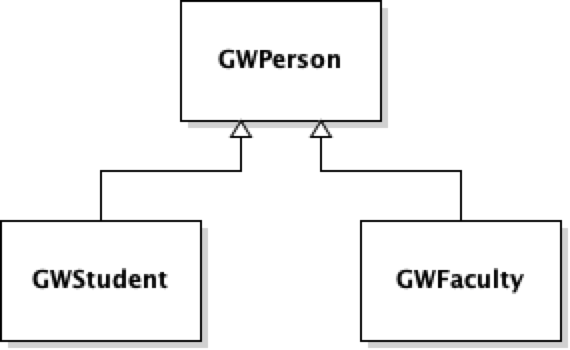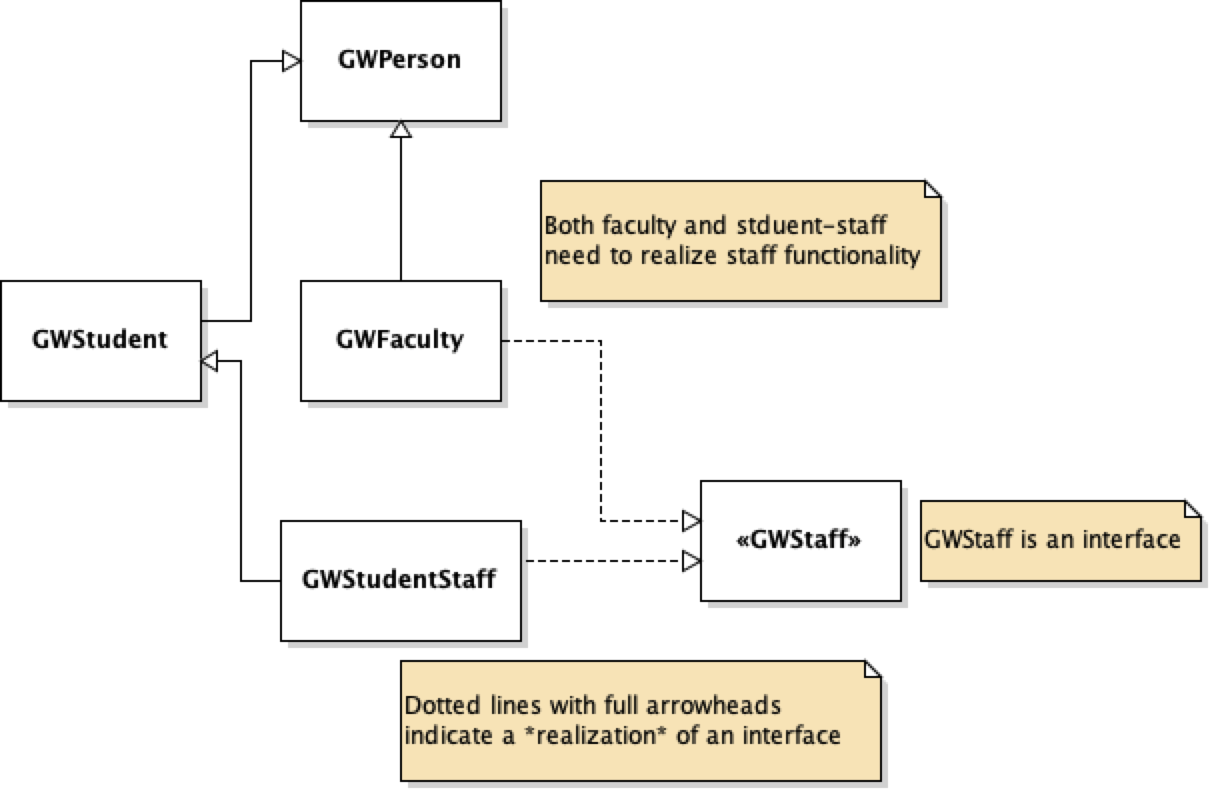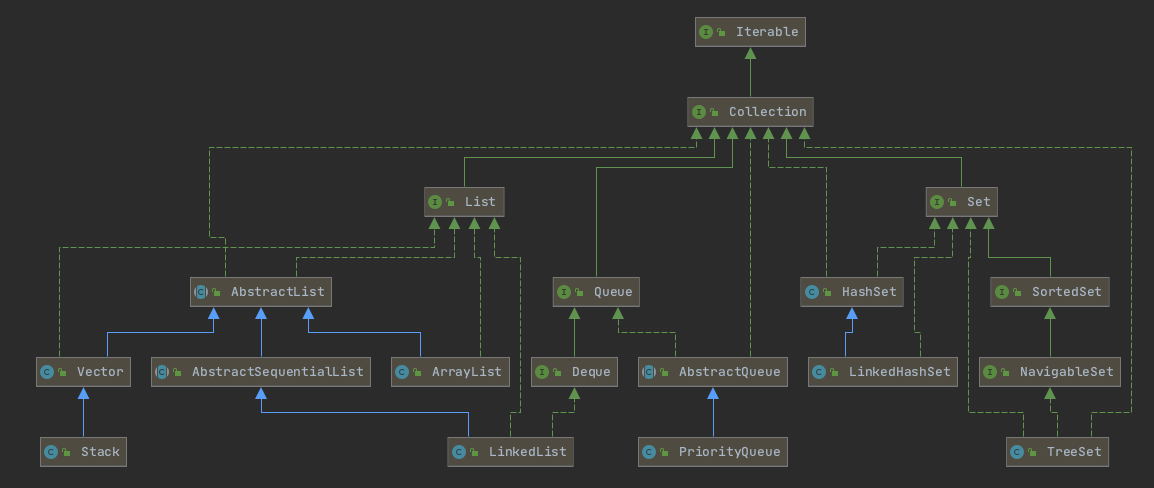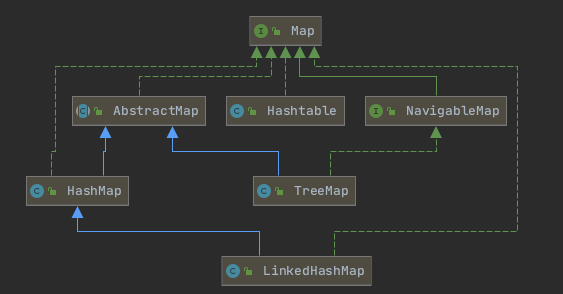Table of Contents
Motivating Interfaces #
The Multiple Inheritance Problem #
Let’s return the example of GWPerson, GWFaculty, and GWStudent example from the prior lesson. As a refresher, we had the following class hierarchy:

Now let’s suppose we want to add another class to this model, GWStaff. Simple enough, we can add the following to our model, and at this point, we should be able to imagine what features a GWStaff member may have.

Ok … now, what if we want to add a class for a student that is also on staff, which is actually quite common due to work study programs and tuition remission programs. Perhaps this class could be a GWStudentStaff and we place it in the diagram like below.

There is nothing necessarily wrong with this model, where GWStudentStaff inherits from both GWStudent and GWStaff and in a number of OOP languages, like C++ and Python, this is totally normal.
In Java, though, you cannot inherit from multiple classes. Java uses a single inheritance model. That means, you can only list one class following an extends statement.
So how do you represent the models like above?
GWStaff Interface #
Within our toy model, we can define the features needed for staff as having two primary functions:
getSalary()andsetSalary(): how much the staff member get’s paidgetManager()andsetManager(): who the staff person reports to
In a world of multiple inheritance, we could imagine defining a class (or abstract class) where these features are defined and would be overwritten in sub-classes. But since there is not multiple inheritance in Java, we instead can define a GWStaff as an interface.
An interface in java is a specification of methods that must be defined when a class implements the interface. It’s essentially, a way to guarantee certain functionality in the class that realizes the implementation.
For example, we’d defined the interface like, below.
public interface GWStaff{
public double getSallary();
public void setSallary(double salary);
public GWPerson getManager();
public void setSallary(GWPerson manager);
}
Note this is the entirety of the code needed to define this interface. The implementation of each of these methods must occur in the class realizing this implementation.
Moreover, thinking of this interface, as faculty are also paid and have a manger, namely the department chair, it would make sense for GWFaculty to also implement this interface. We then get the following class declarations in this model.
public abstract class GWPerson{/*...*/}
public interface GWStaff{/*...*/}
public class GWStudent extends GWPerson{/*...*/}
public class GWFaculty extends GWPerson implements GWStaff{/*...*/}
public class GWStudentStaff extends GWStudent implements GWStaff{/*...*/}
Which we can visualize using the following UML diagram.

Here the solid line with solid arrowheads indicate classes that inerit from another, like GWStudent inherits from GWPerson. A dotted line with a solid arrowhead indicates a class that realizes an interface, like GWFaculty realizing GWStaff. Finally, an interface is annotaed with <<>> markers in its name.
Using interfaces #
Like abstract classes, we can use the interface as the type name, and due to polymorphism, we can have different implementations of that realize that interface. For example, consider a payroll program that determines the total compensation for a collection of staff members.
//array of class that realize the GWStaff interface
GWStaff staff[] = {new GWStudentStaff(/*...*/),
new GWFaculty(/*...*/),
new GWFaculty(/*...*/),
new GWStudentStaff(/*...*/)};
double totalCompensation = 0.0;
for(int i=0;i<staff.length;i++){
totalCompensation += staff[i].getSalary(); //interface ensures that this
//method is implemented
}
In many ways, just like inheritance, realizing an interface is an “is-a” relationship. So we can refer to all classes using the type annotation of the interface. In this case, that would be GWStaff.
Realizing multiple interfaces #
Importantly, a class can implement multiple interfaces. Note that an interface, unlike a class inheritance, does not reuse any code defined in methods nor data members. An interface is simply a contract that a realizing class implements the following features. So it is natural that a class can realize different interfaces.
An example of this, which we take a bit more time to explore below, is in Java collections, which is Java’s built in data structure library. For example, recall from your data structures class that we have a set interface for lists (just for int’s in the example below):
public interface IntList{
public int get(int id);
public void set(int idx,int val);
public void insert(int idx, int val);
public void addToHead(int val);
public void addToTail(int val);
public int rmFromHead();
public int rmFromTail();
public boolean empty();
public int size();
}
A realization of this interface would be a IntLinkedList or an IntArrayList that implements all these methods. But, these same data structures could also realize other APIs, such as IntQueue or IntStack.
public interface IntQueue{
public void enqueue(int val);
public int dequeue();
}
public interface IntStack{
public void push(int val);
public int pop();
}
So when we declare our IntLinkedList (or IntArrayList) we describe that it realizes all interfaces!
public class IntLinkedList implements IntList, IntQueue, IntStack{
// All the LinkedList implementation stuff
//... plus all List methods realized
//IntQueue interface realized
public void enqueue(int val){this.addToHead(val);}
public int dequeue(int val){this.rmFromTail(val);}
//IntStack interface relized
public void push(int val){this.addToHead(val);}
public int pop(int val){this.rmFromHead(val);}
}
Declaring a type for certain interface #
Continuing with the example above of IntList, IntStack, and IntQueue, which should you use in code? For example, what’s the difference between each of the lines of code below?
IntList l = new IntLinkedList();
IntStack s = new IntLinkedList();
IntQueue q = new IntLinkedList();
Technically, l and s and q are all realized by the same underlying class, namely a IntLinkedList, so why call them by different types? The answer is twofold.
First, we use the type annotations of being a list (or a stack, or a queue) to indicate to us (the programmer) the kinds of functionality we are drawing on for our program. Sure, we all know that any reasonable linked list implementation can be used like a stack, but it’s much easier to read the code when we say so explicitly.
Second, when we declare a variable to be a type of the interface, we are restricted the scope of the methods we can call using that type. For example, calling s.addToHead() would cause a compile error – IntStacks do not have a method addToHead().
But we know that s is really a IntLinkedList and does have such a method. So in a way, using a specific interface provides a form of encapsulation of functionality (rather than data) whereby we restrict the methods associated with the realized class such that we get a pure representation of that interface. For example, if we want to use a stack, it doesn’t make sense that we can use s.insert() as this violates the properties of a stack.
Yes, you can cast, but you shouldn’t. #
Casting in java is much like pointer casting in C — it doesn’t change the underlying data, but only how we interpret that data. This make sense because an object in Java is technically a reference type, like a pointer.
So yes, continuing with the example above, we can cast s or q or l to a IntLinkedList if we want and have access to the full functionality. Like the code below:
((IntLinkedList) s).insert(5,10);
But this should feel awkward and wrong. If we wanted s to be a full feature linked list, than it is on the programmer to declare it as such. Casting is a shortcut around the elegance of OOP, and it can also cause unexpected runtime errors.
For example, consider a method that expects IntStack as input, like below.
public void reverseStack(IntStack s){
// which implementation of an IntStack is s?
IntLinkedList l = (IntLinkedList) s; //this could cause a runtime error
//...
}
The programmer is making a strong assumption about the nature of s, specifically it the IntStack is realized via an IntLinkedList and so it can be directly cast. This may not be the case. IntStack could be realized by an IntArrayList or some other class that can realize an IntStack that is yet to be written.
Java Generics and Interface #
Using Object to generalize #
Let’s consider the example of IntList, IntStack and IntQueue interfaces we defined above. One aspect of these interfaces that should appear somewhat abnormal is the Int aspect — they are only defined for lists of ints, a stack of ints, and queue of ints. It would definitely be better if we could define some universe List, Stack and Queue because if we wanted to define an interface for a String (as opposed to an int), we’d need to totally rewrite the interface for every possible Object.
But… couldn’t we take advantage of the fact that all classes extend Object? Yes, and we could define a generic interface for List that uses the Object type. Such as,
public interface List{
public Object get(int idx);
public void set(int idx, Object val);
public void insert(int idx, Object val);
public void addToHead(Object val);
public void addToTail(Object val);
public Object rmFromHead();
public Object rmFromTail();
public boolean empty();
public int size();
}
Now we can define a LinkedList and an ArrayList that realizes this interface at the Object type. (Note the same would be true for Queue and Stack interfaces.)
public class LinkedList extends List{/*...*/};
public class ArrayList extends List{/*...*/};
But using these generic Object version requires casting on insert and removal because the interface is defined for Objects, not neccesarily Strings
List l = new LinkedList();
//cast on insert to generic Object
l.addToHead((Object) "Inserting");
l.addToHead((Object) "strings");
l.addToHead((Object) "into");
l.addToHead((Object) "the");
l.addToHead((Object) "list");
l.addToHead((Object) "requires");
l.addToHead((Object) "casting");
String s="";
while(!l.empty()){
//cast on removal to specific Object
s += (String) l.rmFromTail();
}
System.out.println(s);
Casting by itself is somewhat forgivable, but the fact that Object is the type of transactions and everything inherits from Object means that we can have mixed types within the list.
l.addToHead((Object) "inserting a string");
l.addToHead((Object) new Integer(10)); //or an Integer object
l.addToHead((Object) new Double(3.14)); //or an Double object
//... and many others
While there may be good reasons to mix class types within the list, there are also (often better) reasons to restrict the list to a single type, so you know what class to expect on removal. For example, using the list above, if you were to do a rmFromTail(), how would you properly determine which type to cast back to?!
Java Generics #
The issue of implementing generic interfaces that can function for any class type is a known problem and is solved differently in different languages. In C++, this is solved using templates. Essentially, during compilation, the compiler derives new source code of a generic implementation defined at the specific type. C++ templates are an incredibly powerful tool, but the way it is added to the C++ language would violate some core principals of Java.
Instead, Java took a different approach. Note that the example above with generic Object interfaces is technical correct and if the programmer followed a single type everything would work correctly. In fact, prior to Java 8, this was the recommended way to write generic interfaces. The issue with this approach is that if you want to restrict the class type, there is no way to do so. We need to add an additional annotation to generic interfaces to indicate what class type to expect. Then the compiler can check for that type in your code, ensuring consistency and identifying errors.
This is called java generics, and the class type annotation is noted using <>. For example, we can define our generic List interface with a generic type T that is stand in for Object. As if it is a variable for a more specific type, like String that will be defined later. In fact, java refers to this as the type argument.
public interface List<T>{
public T get(int idx);
public void set(int idx, T val);
public void insert(int idx, T val);
public void addToHead(T val);
public void addToTail(T val);
public T rmFromHead();
public T rmFromTail();
public boolean empty();
public int size();
}
Then when we realize this interface, we continue annotating the generic variable, as if it was passed as an argument in a function call.
public class LinkedList<T> implements List<T> {/*...*/}
Finally, when we instantiate a List, we pass a type argument within <> to indicate at which class type the list should be invoked.
List<String> l = new LinkedList<String>();
l.addToHead("l is expecting String types to be added to it");
And if we tried to insert a non String to l, we would get a compiler error:
l.addToHead(Integer(10)); //<-- this will cause a compiler error
Generics as an Erasure to Object #
Generics in Java are not runtime mechanisms. They are compile time type checks; that is, they are annotations on the class type that can be validated via the type checker to ensure consistency. When the type argument mismatches, you get a compile error, not a runtime error.
Under the hood, after compilation, all the generic type annotation is erased and replaced with Object with appropriate casting. For example,
List<String> l = new LinkedList<String>;
//...
String s = l.rmFromHead();
Becomes the following after erasure
List l = new LinkedList;//no generic type argument
//using Object instead
//...
String s = (String) l.rmFromHead(); //adds cast for type argument
That’s right. You are essentially just using the same generic Object implementations as before when your code actually executes, but you gain an important consistency check to ensure that you don’t mix types. It also makes your code more readable, as you can track which types are used where, and also define multiple generic types. For example, for a generic Map<K,V> that maps some class K to some class V.
Restrictions on Generics #
Because of erasure — that is all generic type arguments are erased to Object — there are a number of restrictions when using generics.
Cannot use primitive types #
Erasure requires all generic types to be objects, not primitive types. So you cannot use int as a type argument, instead you need to use the Object representation of basic types. Such as Integer, Boolean, Double, and etc.
List<Integer> l = new LinkedList<Integer>();
Cannot create instances of generic types #
Consider a generically defined method with a type parameter T
public class FooBarBaz<T>{
public T getT(){
T t = new T(); //<-- compile error
return t;
}
}
Erasure says that T is actually replaced with Object, and if allowed to run it would simply produce a instance of Object, and not of the type T. Worse, you’ll get an invalid cast like below (causing the compile error)
Object t = (T) new Object();
Since T will most likely be some more specific type (that is a class that extends Object), this cast is invalid as a generic Object will not have the functionality of T.
There is a way to still do this using Java reflections — but that’s a discussion for another day.
Cannot create arrays of generic types #
For the same reason as above, you can’t directly create arrays of generic types. Consider the following code:
public class FooBarBaz<T>{
T array[];
public FooBarBaz{
array = new T[];
}
}
After erasure, we again have an odd cast that can cause a type error:
public class FooBarBaz{
Object array[];
public FooBarBaz{
array = (T[]) new Object[];
}
}
Unfortunately, there are not good solutions to this that do not leverage more advanced tools, like Java reflections — still a lesson for another day.
While you can do some fancy casting with arrays of Objects, best practice is to use Java collections when you want generic array-like functionality. This is discussed latter in this unit.
Exploring Common Java Interfaces and their Realizations #
Now that you have some experience with interface and generics, let’s take a moment to explore some common interfaces that you will likely experience.
Comparable Interface #
Perhaps the most common interface is the Comparable interface (see the API). The Comparable interface declares a single method that must be realized:
public interace Comparable<T>{
int compareTo(T o);
}
And like strcmp() in C, this function returns a value less than 0 if this is less than the other object o, greater than 0 if this is greater than the other object o, and 0 if they are equal.
As an example, let’s consider a simple class PiggyBank that tracks how many pennies (1c), nickels (5c), dimes (10c) and quarters (25c) it contains. And we want each PiggyBank to be comparable to other PiggyBanks not on the total value, but the TOTAL number of coins!
public class PiggyBank implements Comparable<PiggyBank>{
private int pennies,nickels,dimes,quarters;
public PiggBank(){ pennies=nickels=dimes=quaerters=0;}
public void addPenny(){pennies++;}
public void addNickel(){nickels++;}
public void addDime(){dimes++;}
public void addQuater(){quarters++;}
public double getDollars(){return .01*pennies +
.05*nickels +
.10*dimes +
.25*quarters;}
public int totalCoins(){return pennies+nickes+dimes+quaters;}
public compareTo(PiggyBank other){
tt =this.totalCoins();
ot = other.totalCoins();
if(tt < ot) return -1;
else if (tt > ot) return 1;
else return 0;
}
}
Noe that the generic type argument for the generic is PiggyBank, we don’t declare a type argument to use within the class. That’s because PiggyBanks are comparable to other PiggyBanks not to any generic type.
However, it may be the case that we want to compare to any subclass of PiggyBank, like a CatBank (… I have no idea what that is, but let’s just say it exists.) Then since CatBank is-a PiggyBank it would make sense we could still compare the two, but the generic type annotation says only PiggyBanks.
Fortunately, generics allows us to describe an upper bound of the type generically. That is, say that it is comparable to all sub-types of the given type.
public class PiggyBank implements Comparable<? extends PiggyBank>{/*...*/}
The ? is a wildcard for which ever type extends PiggBank. The rest of the code remains the same, and we can now do the following comparison without having to cast.
PiggyBank p = new PiggyBank();
CatBank c = new CatBank();
//...
p.compareTo(c);
One final note, when we instantiate a PiggyBank (or a CatBank) we do not pass a type argument. Again, this is because we define a specific type in the class declaration in the generic – it is a PiggyBank, there’s nothing more we can annotate here.
Iterable and Iterator Interface #
Another common interface in Java is the Iterable and Iterator interface. These two interfaces work hand-in-hand to enable for-each iteration in Java. That is, being able to iterate over a collection of objects using the following syntax:
LinkedList<String> l;
//...
for(String s : l){ /*...*/ }
You can find the reference documentation here
Consider if we were implementing a linked list that can store any generic type, and we wanted the linked list to also be iterable. We’d have the following class definition where LinkedList implements Iterable. Note that we are using the generic type annotation, as this linked list annotation can store any type T.
public class LinkedList<T> implements Iterable<T>{
private class Node{
Node next;
T vlaue;
}
private Node head;
public LinkedList(){head=null;}
//... addToHead(), rmFromHead(), etc ...
}
The Iterable interface requires one method to implemented, iterator() which returns an Iterator, which is itself an interface. So to realize the iterator, we have to create a new nested private class that realizes Iterator for this LinkedList.
There are two required methods that must be realized for an Iterator
boolean hasNext(): returnsfalsewhen we’ve reached the end of iterator, otherwise trueT next(): returns the value of the next item in the iteration, and increments the counter.
And we can implement them in a straightforward way by creating a curNode to track our progress in the list
private class LinkedListIterator implements Iterator<T>{
private Node curNode;
public LinkedListIterator(){curNode=head}; //start iteration at head
public boolean hasNext(){return curNode != null;}//exit when reach null
public T next(){
T data = curNode.data; //get the data
curNode = curNode.next; //increment the curNode
return data; //return the data
}
}
The last step is to realize the Iterable interface in our LinkedList by having it return a LinkedListIterator
public Iterator<T> iterator(){
return new LinkedListIterator();
}
With that in place, the following code with a for-each loop is realized
LinkedList<String> l;
//...
for(String s : l){ /*...*/ }
But under the hood, this gets translated into the following while loop using the interface.
Iterator<String> iter = l.iterator(); //Iterable interface
while(iter.hasNext()){ //Iterator interface
String s = iter.getNext(); //Iterator interface
/*...*/
}
Java Collections #
The last interface we’ll discuss here is Java Collection interface, which is actually a family of interfaces that describe any data structure that stores a collection of objects. And of course, all Collections implement Iterable :)
The whole scope of Collection can be viewed in the UML diagram below.

A Collection takes a single generic type argument, Collection<E>, where E is the class of the elements in the collection. To highlight a few important implementations and which interfaces they realize.
LinkedList<E>: implements aList,Queueand also aDeque(which has the same features as aStackArrayList<E>: implements aListand used for random access lists, and has subtypesVector<E>andStack<T>(although, you should probably use aDeque).HashSet<E>: implements aSetTreeSet<E>: also implements aSetbut is navigable in sorted ordered (SortedSetandNavigableSetinterfaces)PriorityQueue<E>: A queue where items are removed with some priority (usually implemented uesing a Heap)
Finally, while not technically a Collection, classes implementing the Map interface are also included in “java collections”. A Map is generic on two type arguments, Map<K,V> as this a key-value store with K the type of the keys and V the type of the value. The full family is shown below in the UML diagram:

The key classes that you will classes you will encounter that realize a Map are:
HashMap<K,V>: A hash table implementation of aMapLinkedHashMap<K,V>: A hash table that useses a linked list to enable iteration of the hash table.TreeMap<K,V>: A (balanced) tree based implementation ofMapthat has the benefit of also being aNavigableMap, so it can be iterated in some order.
Note that in Project 1b, you need to implement your own HashMap and not use java.util.